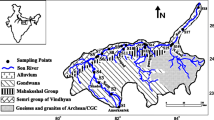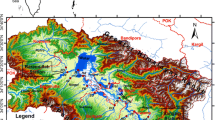Abstract
This study focuses on the characteristics, seasonal variations, and controlling mechanisms of the ionic composition of the Tangra Yumco basin for lake water, river water, and rainfall, which is located in the central Tibetan Plateau. The results showed that Na+ is the major cation in the lake water, Ca2+ is the major cation in the river water and rainfall, and \({\text{HCO}}_{3}^{ - }\) is the major anion in all the water samples. A comparison of the concentrations of calcium in the river water, lake water, and lake sediments reveal significant carbonate precipitation within the lake. The chemical composition of the lake water is mainly controlled by evaporation and crystallization, whereas the compositions of river water and rainfall are mainly controlled by carbonate weathering. Because the TDS content of the river water is lower than the lake water, the TDS content of the lake water is diluted, forming a decreasing trend during the beginning of the Indian summer monsoon. The lake water TDS content then increases rapidly from August to early September due to enhanced evaporation of the lake surface water and the introduction of a large amount of material carried by surface runoff. It then decreases slightly until December due to precipitation in the lake water and less input from the surroundings of the lake.











Similar content being viewed by others
References
Ahlborn M, Haberzettl T, Wang JB, Fürstenberg S, Mäusbacher R, Mazzocco J, Pierson J, Zhu LP, Frenzel P (2016) Holocene lake level history of the Tangra Yumco lake system, southern-central Tibetan Plateau. Holocene 26:176–187. doi:10.1177/0959683615596840
Al-Khashman OA (2005) Ionic composition of wet precipitation in the Petra Region, Jordan. Atmos Res 78:1–12. doi:10.1016/j.atmosres.2005.02.003
Chen JS, Wang FY, Xia XH, Zhang LT (2002) Major element chemistry of the Changjiang (Yangtze River). Chem Geol 187:231–255. doi:10.1016/S0009-2541(02)00032-3
Cui BL, Li XY (2015) Runoff processes in the Qinghai Lake Basin, Northeast Qinghai-Tibet Plateau, China: insights from stable isotope and hydrochemistry. Quat Int 380:123–132. doi:10.1016/j.quaint.2015.02.030
Dalai TK, Krishnaswami S, Sarin MM (2002) Major ion chemistry in the headwaters of the Yamuna River system: chemical weathering, its temperature dependence and CO2 consumption in the Himalaya. Geochim Cosmochim Acta 66:3397–3416. doi:10.1016/S0016-7037(02)00937-7
Gao YF, Hou ZQ, Kamber BS, Wei RH, Meng XJ, Zhao RS (2007) Lamproitic rocks from a continental collision zone: evidence for recycling of subducted Tethyan oceanic sediments in the mantle beneath southern Tibet. J Petrol 48:729–752. doi:10.1093/petrology/egl080
Gao YF, Wei RH, Ma PX, Hou ZQ, Yang ZS (2009) Post-collisional ultrapotassic volcanism in the Tangra Yumco-Xuruco graben, south Tibet: constraints from geochemistry and Sr–Nd–Pb isotope. Lithos 110:129–139. doi:10.1016/j.lithos.2008.12.005
Garrels RM, Mackenzie FT (1971) Evolution of sedimentary rocks. W.W. Norton, New York
Gibbs RJ (1970) Mechanisms controlling world water chemistry. Science 170:1088–1090
Gillette DA, Sinclair PC (1990) Estimation of suspension of alkaline material by dust devils in the United States. Atmos Environ Part A Gen Top 24:1135–1142. doi:10.1016/0960-1686(90)90078-2
Guo WQ, Liu SY, Xu JL, Wu LZ, Shangguan DH, Yao XJ, Wei JF, Bao WJ, Yu PC, Liu Q, Jiang ZL (2015) The second Chinese glacier inventory: data, methods and results. J Glaciol 61:357–372. doi:10.3189/2015JoG14J209
Han YX, Xi XX, Song LC, Ye YH, Li YH (2004) Spatio-temporal sand-dust distribution in Qinghai-Tibet Plateau and its climatic significance. J Desert Res 24:588–592 (in Chinese)
Henkel K, Haberzettl T, St-Onge G, Wang JB, Ahlborn M, Daut G, Zhu LP, Mäusbacher R (2016) High-resolution paleomagnetic and sedimentological investigations on the Tibetan Plateau for the past 16 ka cal B.P.—the Tangra Yumco record. Geochem Geophys Geosyst 17:774–790. doi:10.1002/2015GC006023
Hu MH, Stallard RF, Edmond JM (1982) Major ion chemistry of some large Chinese rivers. Nature 298:550–553
Institute of Geography Beijing (1990) Atlas of Tibet Plateau. Institute of Geography, Chinese Academy of Sciences, Beijing
Ju JT, Zhu LP, Wang JB, Xie MP, Zhen XL, Wang Y, Peng P (2010) Water and sediment chemistry of Lake Pumayum Co, South Tibet, China: implications for interpreting sediment carbonate. J Palaeolimnol 43:463–474. doi:10.1007/s10933-009-9343-6
Junge CE (1963) Air chemistry and radioactivity. Academic Press, New York
Junge CE (1972) Our knowledge of the physico-chemistry of aerosols in the undisturbed marine environment. J Geophys Res 77:5183–5200. doi:10.1029/JC077i027p05183
Kilham P (1990) Mechanisms controlling the chemical composition of lakes and rivers: data from Africa. Limnol Oceanogr 35:80–83. doi:10.4319/lo.1990.35.1.0080
Kong P, Na CG, Brown R, Fabel D, Freeman S, Xiao W, Wang YJ (2011) Cosmogenic 10Be and 26Al dating of paleolake shorelines in Tibet. J Asian Earth Sci 41:263–273. doi:10.1016/j.jseaes.2011.02.016
Laba B, Chen T, Bianba C, Zhuoma Y, Laba Z (2012) Possible causes of area changes of Lake Tangra Yumco, Tibet based on TM images. Meteogol Sci Technol 40:685–688 (in Chinese)
Li CL, Kang SC, Zhang QG, Kaspari S (2007) Major ionic composition of precipitation in the Nam Co region, Central Tibetan Plateau. Atmos Res 85:351–360. doi:10.1016/j.atmosres.2007.02.006
Long H, Lai ZP, Frenzel P, Fuchs M, Haberzettl T (2012) Holocene moist period recorded by the chronostratigraphy of a lake sedimentary sequence from Lake Tangra Yumco on the south Tibetan Plateau. Quat Geochronol 10:136–142. doi:10.1016/j.quageo.2011.11.005
Meybeck M, Helmer R (1989) The quality of rivers: from pristine stage to global pollution. Glob Planet Change 1:283–309. doi:10.1016/0921-8181(89)90007-6
Miehe S, Miehe G, van Leeuwen JFN, Wrozyna C, van der Knaap WO, Duo L, Haberzettl T (2014) Persistence of Artemisia steppe in the Tangra Yumco Basin, west-central Tibet, China: despite or in consequence of Holocene lake-level changes? J Paleolimnol 51:267–285. doi:10.1007/s10933-013-9720-z
Mitamura O, Seike Y, Kondo K, Goto N, Anbutsu K, Akatsuka T, Kihira M, Tsering TQ, Nishimura M (2003) First investigation of ultraoligotrophic alpine Lake Puma Yumco in the pre-Himalayas, China. Limnology 4:167–175. doi:10.1007/s10201-003-0101-6
Murakami T, Terai H, Yoshiyama Y, Tezuka T, Zhu L, Matsunaka T, Nishimura M (2007) The second investigation of Lake Puma Yum Co located in the Southern Tibetan Plateau, China. Limnology 8:331–335. doi:10.1007/s10201-007-0208-2
Negrel P, Roy S (1998) Chemistry of rainwater in the Massif Central (France): a strontium isotope and major element study. Appl Geochem 13:941–952. doi:10.1016/S0883-2927(98)00029-8
Rades EF, Hetzel R, Xu Q, Ding L (2013) Constraining Holocene lake-level highstands on the Tibetan Plateau by 10Be exposure dating: a case study at Tangra Yumco, southern Tibet. Quat Sci Rev 82:68–77. doi:10.1016/j.quascirev.2013.09.016
Rajeevan M, Rohini P, Niranjan Kumar K, Srinivasan J, Unnikrishnan CK (2012) A study of vertical cloud structure of the Indian summer monsoon using CloudSat data. Clim Dyn 40:637–650. doi:10.1007/s00382-012-1374-4
Sarin MM, Krishnasswami S (1984) Major ion chemistry of the Ganga–Brahamputra river systems, India. Nature 312:538–541
Shao ZG, Meng XG, Zhu DG, Zheng DX, Qiao ZJ, Yang CB, Han JE, Yu J, Meng QW, Lü RP (2008) Characteristics of the change of major lakes on the Qinghai-Tibet Plateau in the last 25 years. Front Earth Sci China 2:364–377. doi:10.1007/s11707-008-0038-5
Shen ZL, Zhu WH, Zhong ZS (1993) Basic knowledge on hydrological geochemistry. Geology Press, Beijing, pp 62–93 (in Chinese)
Song CQ, Huang B, Ke LH (2013) Modeling and analysis of lake water storage changes on the Tibetan Plateau using multi-mission satellite data. Remote Sens Environ 135:25–35. doi:10.1016/j.rse.2013.03.013
Stallard RF, Edmond JM (1983) Geochemistry of the Amazon: 2. The influence of geology and weathering environment on the dissolved load. J Geophys Res Oceans (1978–2012) 88(C14):9671–9688. doi:10.1029/JC088iC14p09671
Stumm W (1992) Chemistry of the solid–water interface. Wiley, New York
Wang B (2006) The Asian Monsoon. Springer, Chichester
Wang JB, Peng P, Ma QF, Zhu LP (2010a) Modern limnological features of Tangra Yumco and Zhari Namco, Tibetan Plateau. J Lake Sci 22:629–632 (in Chinese)
Wang JB, Zhu LP, Wang Y, Ju JT, Xie MP, Daut G (2010b) Comparisons between the chemical compositions of lake water, inflowing river water, and lake sediment in Nam Co, central Tibetan Plateau, China and their controlling mechanisms. J Great Lakes Res 36:587–595. doi:10.1016/j.jglr.2010.06.013
Wang JB, Zhu LP, Wang Y, Peng P, Ma QF, Haberzettl T, Kasper T, Matsunaka T, Nakamura T (2015) Variability of the 14C reservoir effects in Lake Tangra Yumco, Central Tibet (China), determined from recent sedimentation rates and dating of plant fossils. Quat Int. doi:10.1016/j.quaint.2015.10.084
Wang R, Liu ZF, Jiang LG, Yao ZJ, Wang JB, Ju JT (2016) Comparison of surface water chemistry and weathering effects of two lake basins in the Changtang Nature Reserve, China. J Environ Sci (China) 41:183–194. doi:10.1016/j.jes.2015.03.016
Xu H, Hou ZH, An ZS, Liu XY, Dong JB (2010) Major ion chemistry of waters in Lake Qinghai catchments, NE Qinghai-Tibet plateau, China. Quat Int 212:35–43. doi:10.1016/j.quaint.2008.11.001
Yang YB, Fang XM, Galy A, Zhang GX, Liu SC, Zan JB, Wu FL, Meng QQ, Ye CC, Yang RS, Liu XM (2015) Carbonate composition and its impact on fluvial geochemistry in the NE Tibetan Plateau region. Chem Geol 410:138–148. doi:10.1016/j.chemgeo.2015.06.009
Yao ZJ, Wang R, Liu ZF, Wu SS, Jiang LG (2015) Spatial-temporal patterns of major ion chemistry and its controlling factors in the Manasarovar Basin, Tibet. J Geogr Sci 25:687–700. doi:10.1007/s11442-015-1196-5
Zhang J, Huang WW, Letolle R, Jusserand C (1995) Major element chemistry of the Huanghe (Yellow River), China-weathering processes and chemical fluxes. J Hydrol 168:173–203. doi:10.1016/0022-1694(94)02635-O
Zhang DD, Peart M, Jim CY, He YQ, Li BS, Chen JA (2003) Precipitation chemistry of Lhasa and other remote towns, Tibet. Atmos Environ 37:231–240. doi:10.1016/S1352-2310(02)00835-X
Zhang GQ, Xie HJ, Kang SC, Yi DH, Ackley SF (2011a) Monitoring lake level changes on the Tibetan Plateau using ICESat altimetry data (2003–2009). Remote Sens Environ 115:1733–1742. doi:10.1016/j.rse.2011.03.005
Zhang L, Song XF, Xia J, Yuan RQ, Zhang YY, Liu X, Han DM (2011b) Major element chemistry of the Huai River basin, China. Appl Geochem 26:293–300. doi:10.1016/j.apgeochem.2010.12.002
Zhang GQ, Yao TD, Xie HJ, Zhang KX, Zhu FJ (2014) Lakes’ state and abundance across the Tibetan Plateau. Chin Sci Bull 59:3010–3021. doi:10.1007/s11434-014-0258-x
Zhu BQ, Yang XP (2007) Water chemistries in the natural waters and their formations in the Taklamakan Desert. Chin Sci Bull 52:2123–2129 (in Chinese)
Acknowledgements
We would like to thank the anonymous reviewers for improving the manuscript who gives helpful comments. We are grateful to Yong Wang, Qingfeng Ma, Jianting Ju, Ping Peng, Feng Chen, Ruimin Yang, Yun Guo and Gerhard Daut for their participation in the fieldwork and/or assistance with the laboratory analysis. We also thank Zhiyong Zhu, who completed most of the analysis in the laboratory in Lhasa. This work was jointly supported by the National Natural Science Foundation of China (41271225), the CAS Strategic Priority Research Program (XDB03030000) and the Chinese MOST Projects (2012CB956100, 2012FY111400).
Author information
Authors and Affiliations
Corresponding author
Rights and permissions
About this article
Cite this article
Qiao, B., Wang, J., Huang, L. et al. Characteristics and seasonal variations in the hydrochemistry of the Tangra Yumco basin, central Tibetan Plateau, and responses to the Indian summer monsoon. Environ Earth Sci 76, 162 (2017). https://doi.org/10.1007/s12665-017-6479-y
Received:
Accepted:
Published:
DOI: https://doi.org/10.1007/s12665-017-6479-y




